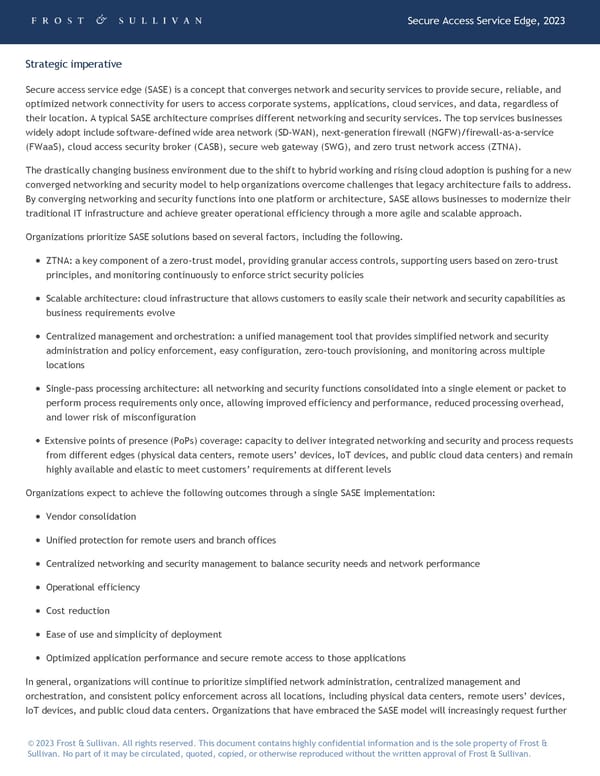Secure Access Service Edge, 2023 Strategic imperative Secure access service edge (SASE) is a concept that converges network and security services to provide secure, reliable, and optimized network connectivity for users to access corporate systems, applications, cloud services, and data, regardless of their location. A typical SASE architecture comprises different networking and security services. The top services businesses widely adopt include software-defined wide area network (SD-WAN), next-generation firewall (NGFW)/firewall-as-a-service (FWaaS), cloud access security broker (CASB), secure web gateway (SWG), and zero trust network access (ZTNA). The drastically changing business environment due to the shift to hybrid working and rising cloud adoption is pushing for a new converged networking and security model to help organizations overcome challenges that legacy architecture fails to address. By converging networking and security functions into one platform or architecture, SASE allows businesses to modernize their traditional IT infrastructure and achieve greater operational efficiency through a more agile and scalable approach. Organizations prioritize SASE solutions based on several factors, including the following. ZTNA: a key component of a zero-trust model, providing granular access controls, supporting users based on zero-trust principles, and monitoring continuously to enforce strict security policies Scalable architecture: cloud infrastructure that allows customers to easily scale their network and security capabilities as business requirements evolve Centralized management and orchestration: a unified management tool that provides simplified network and security administration and policy enforcement, easy configuration, zero-touch provisioning, and monitoring across multiple locations Single-pass processing architecture: all networking and security functions consolidated into a single element or packet to perform process requirements only once, allowing improved efficiency and performance, reduced processing overhead, and lower risk of misconfiguration Extensive points of presence (PoPs) coverage: capacity to deliver integrated networking and security and process requests from different edges (physical data centers, remote users’ devices, IoT devices, and public cloud data centers) and remain highly available and elastic to meet customers’ requirements at different levels Organizations expect to achieve the following outcomes through a single SASE implementation: Vendor consolidation Unified protection for remote users and branch offices Centralized networking and security management to balance security needs and network performance Operational efficiency Cost reduction Ease of use and simplicity of deployment Optimized application performance and secure remote access to those applications In general, organizations will continue to prioritize simplified network administration, centralized management and orchestration, and consistent policy enforcement across all locations, including physical data centers, remote users’ devices, IoT devices, and public cloud data centers. Organizations that have embraced the SASE model will increasingly request further © 2023 Frost & Sullivan. All rights reserved. This document contains highly confidential information and is the sole property of Frost & Sullivan. No part of it may be circulated, quoted, copied, or otherwise reproduced without the written approval of Frost & Sullivan.
 The Top SASE Provider 2023 Cato Networks Page 3 Page 5
The Top SASE Provider 2023 Cato Networks Page 3 Page 5